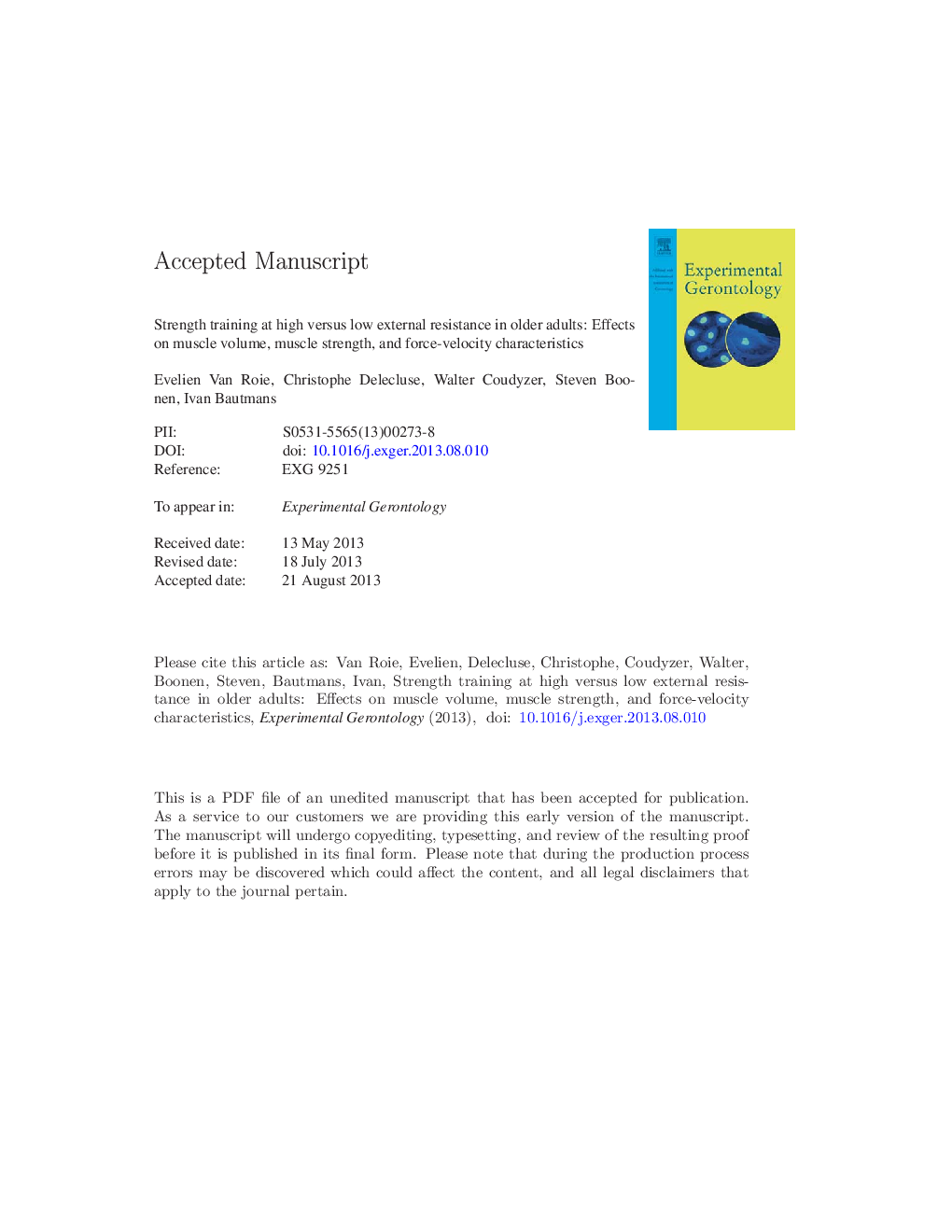| کد مقاله | کد نشریه | سال انتشار | مقاله انگلیسی | نسخه تمام متن |
|---|---|---|---|---|
| 10736828 | 1046272 | 2013 | 55 صفحه PDF | دانلود رایگان |
عنوان انگلیسی مقاله ISI
Strength training at high versus low external resistance in older adults: Effects on muscle volume, muscle strength, and force-velocity characteristics
ترجمه فارسی عنوان
آموزش قدرت در مقابله با مقاومت بیرونی بالا در افراد بالای سالم: تاثیر در حجم عضلانی، قدرت عضلانی و ویژگی های سرعت نیرو
دانلود مقاله + سفارش ترجمه
دانلود مقاله ISI انگلیسی
رایگان برای ایرانیان
کلمات کلیدی
هیپرتروفی عضلانی، آموزش مقاومت بار آموزش خستگی عضلانی، مسن،
موضوعات مرتبط
علوم زیستی و بیوفناوری
بیوشیمی، ژنتیک و زیست شناسی مولکولی
سالمندی
چکیده انگلیسی
Muscle adaptations can be induced by high-resistance exercise. Despite being potentially more suitable for older adults, low-resistance exercise protocols have been less investigated. We compared the effects of high- and low-resistance training on muscle volume, muscle strength, and force-velocity characteristics. Fifty-six older adults were randomly assigned to 12 weeks of leg press and leg extension training at either HIGH (2 Ã 10-15 repetitions at 80% of one repetition maximum (1RM)), LOW (1 Ã 80-100 repetitions at 20% of 1RM), or LOW + (1 Ã 60 repetitions at 20% of 1RM, followed by 1 Ã 10-20 repetitions at 40% of 1RM). All protocols ended with muscle failure. Leg press and leg extension of 1RM were measured at baseline and post intervention and before the first training session in weeks 5 and 9. At baseline and post intervention, muscle volume (MV) was measured by CT-scan. A Biodex dynamometer evaluated knee extensor static peak torque in different knee angles (PTstat90°, PTstat120°, PTstat150°), dynamic peak torque at different speeds (PTdyn60°sâ 1, PTdyn180°sâ 1, PTdyn240°sâ 1), and speed of movement at 20% (S20), 40% (S40), and 60% (S60) of PTstat90°. HIGH and LOW + resulted in greater improvements in 1RM strength than LOW (p < 0.05). These differences were already apparent after week 5. Similar gains were found between groups in MV, PTstat, PTdyn60°sâ 1, and PTdyn180°sâ 1. No changes were reported in speed of movement. HIGH tended to improve PTdyn240°sâ 1 more than LOW or LOW + (p = 0.064). In conclusion, high- and low-resistance exercises ending with muscle failure may be similarly effective for hypertrophy. High-resistance training led to a higher increase in 1RM strength than low-resistance training (20% of 1RM), but this difference disappeared when using a mixed low-resistance protocol in which the resistance was intensified within a single exercise set (40% of 1RM). Our findings support the need for more research on low-resistance programs in older age, in particular long-term training studies and studies focusing on residual effects after training cessation.
ناشر
Database: Elsevier - ScienceDirect (ساینس دایرکت)
Journal: Experimental Gerontology - Volume 48, Issue 11, November 2013, Pages 1351-1361
Journal: Experimental Gerontology - Volume 48, Issue 11, November 2013, Pages 1351-1361
نویسندگان
Evelien Van Roie, Christophe Delecluse, Walter Coudyzer, Steven Boonen, Ivan Bautmans,
